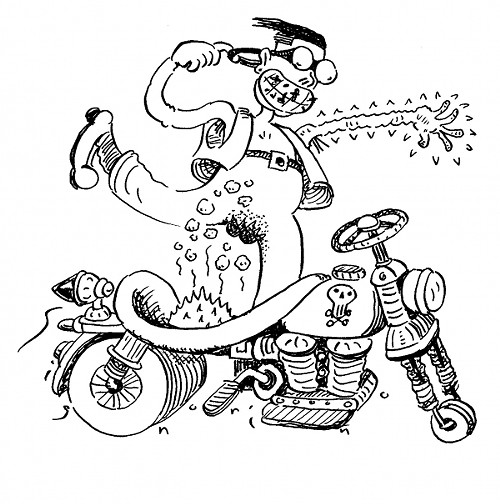Bad Vibrations
I use my motorbike daily to get around. Last week, my mom said the vibrations from the tank could damage my sperm. Is there any truth to this?
By Cecil AdamsI use my motorbike daily to get around. Last week, my mom said the vibrations from the tank could damage my sperm. Is there any truth to this?
—Shiki Amsel
Times sure have changed. When I was growing up, never once did my mom ask about my sperm count.
Nonetheless, your mother may not be too far off base. Motorcycle exhaust greatly reduces sperm count in lab rats, and long-distance bicyclists have been found to suffer from reduced sperm count due to overheating of the testes. But you’re missing the bigger picture here—having sperm does you no good if you can’t deliver them. The real danger is what the Cialis ads refer to as erectile dysfunction or, for the really squeamish, ED.
Earlier research focused on the potential risks to men’s nether regions from bicycling. Here, the root cause seems to be compression of the perineum—the patch of skin and muscle situated between the two major anogenital landmarks. Parking your perineum on a bike seat, particularly a narrow one, for too long apparently puts so much pressure on critical nerves and blood vessels that some male riders find they can’t get it up. A metastudy found that more than half of male bicyclists suffered from genital numbness, and between roughly an eighth and a quarter said they suffered from the dreaded ED. Female cyclists don’t have it any better, reporting numbness, difficult urination, pain and difficulty achieving orgasm.
It’s not obvious motorcycling would have similar effects. Motorcycle saddles are generally much larger and better padded than those on bicycles, and you’d think the shock absorbers on a motorcycle would help insulate the rider from harsh road vibration.
But maybe not. A Japanese study of 234 avid motorcyclists between the ages of 20 and 60 found significantly higher ED across all age ranges compared to a control group. Sixty-nine percent of motorcyclists suffered from ED compared to 35 percent of the controls. Among bikers aged 50 to 59, a staggering 93 percent had ED, compared to 42 percent of the controls. A subsequent study of 150 Japanese motorcyclists by the same authors found that not only was the rate of ED more than three times greater among motorcyclists than the control group, but there was a clear link between their ED and other lower-urinary-tract disorders.
What causes these problems? Sure enough, the likeliest culprit is constant vibration, from both the engine and the road. Research on those occupationally exposed to what clinicians call whole body vibration, or WBV, including forklift operators and bus and truck drivers, has found they’re prone to problems ranging from lower back pain to spinal degeneration and herniated disks. Studies of motorcycle riders suggest they can exceed recommended WBV limits in a quarter of the road time it would take a car driver.
Impotence isn’t the only thing motorcyclists have to worry about. All that vibration can lead to finger, hand, arm and shoulder injuries. A study of police motorcyclists found nearly 20 percent had numb fingers and 45 percent suffered shoulder stiffness. Hearing loss among motorcyclists is common due to loud exhaust and wind noise.
And, of course, motorcycles by their very nature are more dangerous than automobiles. In 2010, 4,502 U.S. riders were killed in accidents, meaning that motorcycles accounted for 14 percent of traffic fatalities but less than 1 percent of vehicle miles traveled. Many of these deaths for practical purposes were self-inflicted—of the 14,000-plus cyclists killed from 2008 to 2010, 42 percent weren’t wearing a helmet.
You think I’m building up to a big finish about the curse of motorcycling. On the contrary: The well-demonstrated masochism of the sport’s aficionados makes them a remarkable resource. Aging bikers’ impotence isn’t readily monetized, I acknowledge, but the reluctance to wear helmets is another story. Younger bikers especially are veritable plantations of harvestable organs.
Motorcyclists are commonly thought to be the No. 1 source of organ donors, the stereotypical fatality being a helmetless young male who dies of head injuries while leaving the rest of his body intact. That’s an exaggeration. Motor vehicle accident victims in general account for 20 percent of organ donors; depending on the year, 12 to 14 percent of that number die in motorcycle accidents, giving us a biker organ-donation rate of under 3 percent.
Still, that’s a lot of organs. It’s been half-seriously suggested that A. laws mandating helmet use should be repealed, and B. bikers killed in accidents while helmetless should be presumed ipso facto to have given donor consent. Assuming 4,500 annual motorcycle fatalities, 42 percent helmetlessness and an average of 2.7 organs successfully transplanted per donor, we get 5,100 potentially harvestable organs. The way I see it, wear a helmet or don’t—either way you could be saving someone’s life.
Send questions to Cecil via StraightDope.com or write him c/o Chicago Reader, 350 N. Orleans, Chicago 60654. Subscribe to the Straight Dope podcast at iTunes.
Speaking of...
-
Shooting Blanks
Do gun buybacks work?
- May 19, 2014
- More »
More by Cecil Adams
-
This Is the End, My Friend
This week's Straight Dope marks the last appearance of the column as the Teeming Millions have known it for the past 45 years.
- Jul 11, 2018
-
Do Brain Supplements Do Anything?
Brain Drain
- Jul 4, 2018
-
Is flying really worse for the environment than driving?
Planes and Trains
- Jun 27, 2018
- More »




